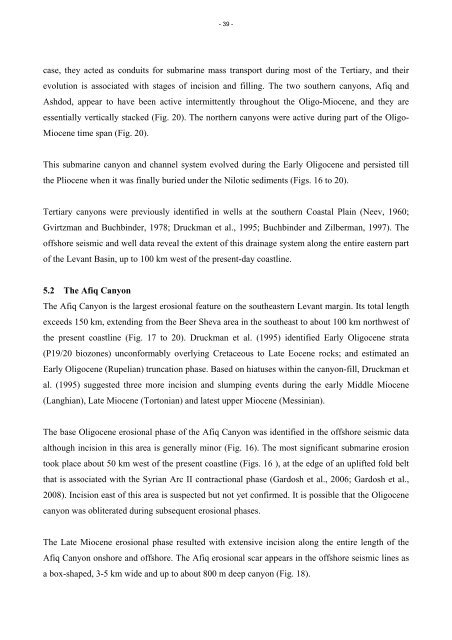The Oligo-Miocene deepwater system of the Levant Basin
The Oligo-Miocene deepwater system of the Levant Basin
The Oligo-Miocene deepwater system of the Levant Basin
Create successful ePaper yourself
Turn your PDF publications into a flip-book with our unique Google optimized e-Paper software.
- 39 -case, <strong>the</strong>y acted as conduits for submarine mass transport during most <strong>of</strong> <strong>the</strong> Tertiary, and <strong>the</strong>irevolution is associated with stages <strong>of</strong> incision and filling. <strong>The</strong> two sou<strong>the</strong>rn canyons, Afiq andAshdod, appear to have been active intermittently throughout <strong>the</strong> <strong>Oligo</strong>-<strong>Miocene</strong>, and <strong>the</strong>y areessentially vertically stacked (Fig. 20). <strong>The</strong> nor<strong>the</strong>rn canyons were active during part <strong>of</strong> <strong>the</strong> <strong>Oligo</strong>-<strong>Miocene</strong> time span (Fig. 20).This submarine canyon and channel <strong>system</strong> evolved during <strong>the</strong> Early <strong>Oligo</strong>cene and persisted till<strong>the</strong> Pliocene when it was finally buried under <strong>the</strong> Nilotic sediments (Figs. 16 to 20).Tertiary canyons were previously identified in wells at <strong>the</strong> sou<strong>the</strong>rn Coastal Plain (Neev, 1960;Gvirtzman and Buchbinder, 1978; Druckman et al., 1995; Buchbinder and Zilberman, 1997). <strong>The</strong><strong>of</strong>fshore seismic and well data reveal <strong>the</strong> extent <strong>of</strong> this drainage <strong>system</strong> along <strong>the</strong> entire eastern part<strong>of</strong> <strong>the</strong> <strong>Levant</strong> <strong>Basin</strong>, up to 100 km west <strong>of</strong> <strong>the</strong> present-day coastline.5.2 <strong>The</strong> Afiq Canyon<strong>The</strong> Afiq Canyon is <strong>the</strong> largest erosional feature on <strong>the</strong> sou<strong>the</strong>astern <strong>Levant</strong> margin. Its total leng<strong>the</strong>xceeds 150 km, extending from <strong>the</strong> Beer Sheva area in <strong>the</strong> sou<strong>the</strong>ast to about 100 km northwest <strong>of</strong><strong>the</strong> present coastline (Fig. 17 to 20). Druckman et al. (1995) identified Early <strong>Oligo</strong>cene strata(P19/20 biozones) unconformably overlying Cretaceous to Late Eocene rocks; and estimated anEarly <strong>Oligo</strong>cene (Rupelian) truncation phase. Based on hiatuses within <strong>the</strong> canyon-fill, Druckman etal. (1995) suggested three more incision and slumping events during <strong>the</strong> early Middle <strong>Miocene</strong>(Langhian), Late <strong>Miocene</strong> (Tortonian) and latest upper <strong>Miocene</strong> (Messinian).<strong>The</strong> base <strong>Oligo</strong>cene erosional phase <strong>of</strong> <strong>the</strong> Afiq Canyon was identified in <strong>the</strong> <strong>of</strong>fshore seismic dataalthough incision in this area is generally minor (Fig. 16). <strong>The</strong> most significant submarine erosiontook place about 50 km west <strong>of</strong> <strong>the</strong> present coastline (Figs. 16 ), at <strong>the</strong> edge <strong>of</strong> an uplifted fold beltthat is associated with <strong>the</strong> Syrian Arc II contractional phase (Gardosh et al., 2006; Gardosh et al.,2008). Incision east <strong>of</strong> this area is suspected but not yet confirmed. It is possible that <strong>the</strong> <strong>Oligo</strong>cenecanyon was obliterated during subsequent erosional phases.<strong>The</strong> Late <strong>Miocene</strong> erosional phase resulted with extensive incision along <strong>the</strong> entire length <strong>of</strong> <strong>the</strong>Afiq Canyon onshore and <strong>of</strong>fshore. <strong>The</strong> Afiq erosional scar appears in <strong>the</strong> <strong>of</strong>fshore seismic lines asa box-shaped, 3-5 km wide and up to about 800 m deep canyon (Fig. 18).
















